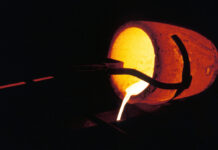
COBUS Loots is keeping upbeat despite a foray into Sudan’s gold sector taking an unexpected turn. On April 15, four days announcing the granting of several exploration licences in the north African country, hostilities broke out between government army forces and a rebel paramilitary. Less than a month later, Pan African evacuated staff.
Exploration in Sudan represented a major step-out in strategy for Pan African, which exclusively mines in South Africa. In retrospect, however, it’s not a totally inconsistent choice of destination. After all, the firm’s biggest project is Mintails, west of Johannesburg, where illegal miners (zama zamas) fight over abandoned gold mines — a conflict zone of sorts.
But why Sudan, exactly?
“Well, because there’s a crap load of gold,” says Loots in an interview. “It’s completely underexplored.” He also says his company looked at opportunities in West Africa, but couldn’t make an investment case. “Where can we go where there’s literally ‘elephant country’?”
While Loots is “convinced” of Sudan’s geological merits he has to wait until meandering peace talks make it safe to return. Meanwhile, back in South Africa, the company is about to press the button on the R2.5bn Mintails. The property, consisting of low-grade remnant gold near Krugersdorp, is in desperate need of effective policing. Panyazi Lesufi, premier of Gauteng province, has promised Loots that government will come to the company’s aid.
Pan African says there’s a tacit rather than negotiated understanding with the zama zamas. So far, boundaries have been honoured, says Hethen Hira, head of Pan African’s investor relations. “They’re up there on that hill and they’ve got their own targets. Initially there were a couple of gunshots fired,” he says. Currently, the situation is calm.
Loots says the company is prepared for contingencies at Mintails although he won’t go into the extent of the security detail: “It’s not only security; it’s about creating an environment.” The mine creates thousands of new jobs, and given the social fall-out in the region, appears to have government support.
“There is a lot of negativity around it but there’s nowhere else in the world you can buy two million ounces on surface for $3m. Where else can you do that?” says Loots.
It’s critical Mintails works for Pan African because it’s on a push to attract more US shareholders. Once up and running, Mintails will mean half of Pan African’s 200,000 oz in annual gold production is from low-cost surface resources. ‘Growing down the cost curve’, as it’s called in the mining industry, is what investors want to hear. Since making shares available in New York, Pan African has increased US investors to 6% from 1.5% of its share register, but it wants more.
What hasn’t helped its cause is an undershoot of production targets at mines in Mpumalanga province. This spooked investors and resulted in the firm missing a large part of the higher rand gold price. But Loots is hoping to catch up provided he can address a lack of liquidity in the stock, a feature of Pan African that has been a barrier in the past.
“Our dividend yield is right up there versus any of the international companies in terms of portfolio growth; we have an asset that’s coming on in the next 18 months that’s going to add 25% to our production,” says Loots.
“That’s where being a bit smaller is a bit of a differentiation. You can still grow.”
This article first appeared in the The Mining Yearbook 2023 available here.











